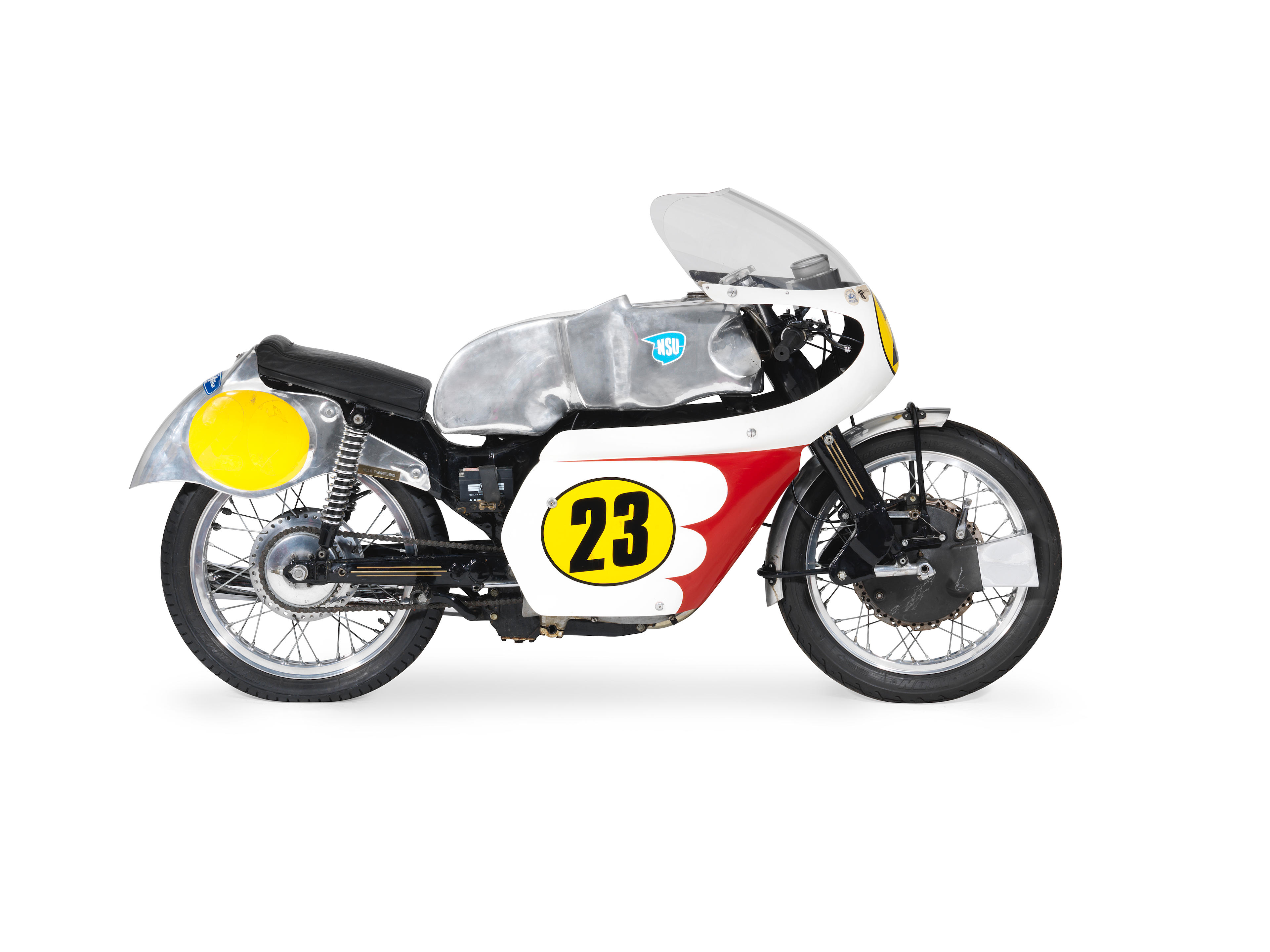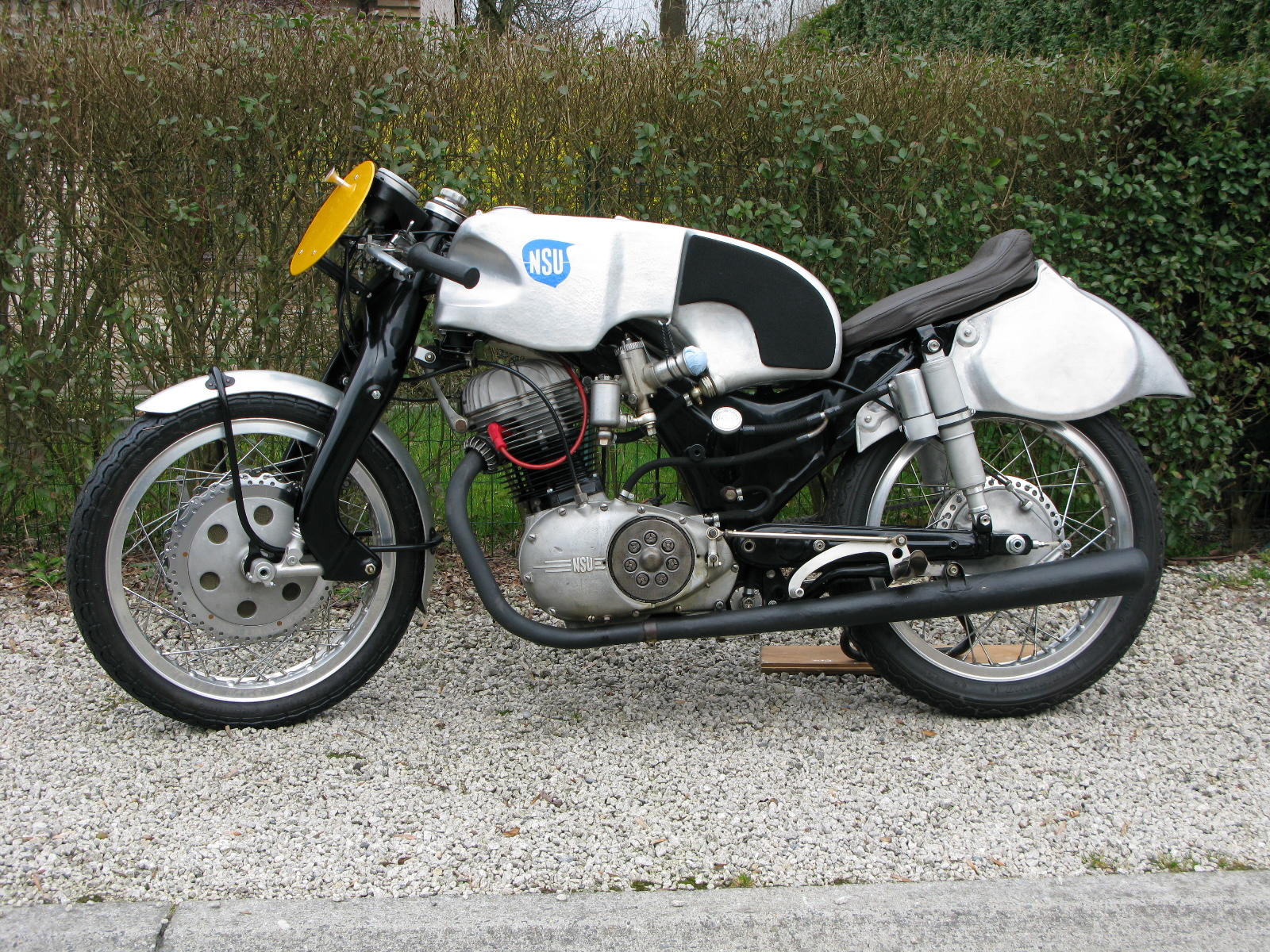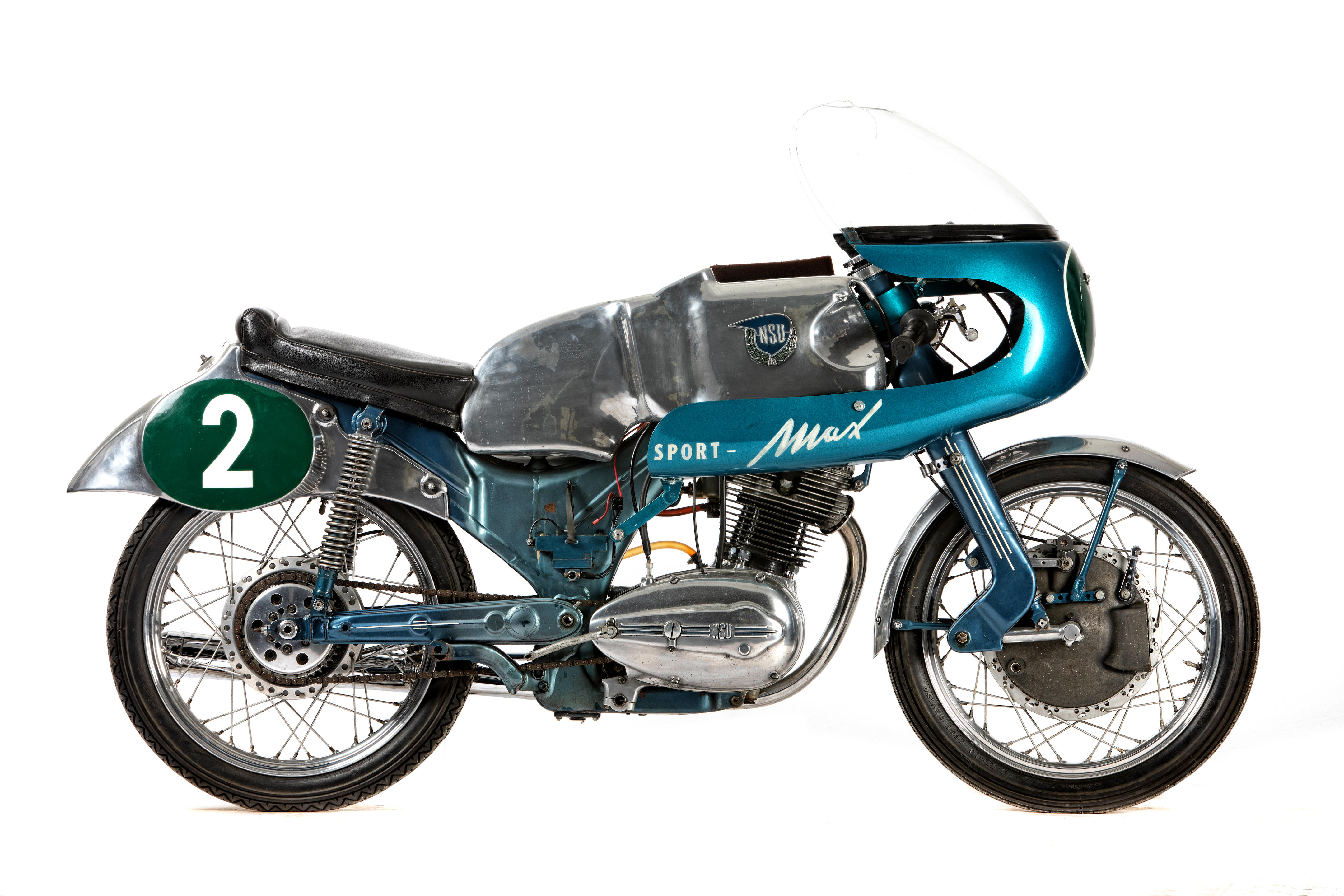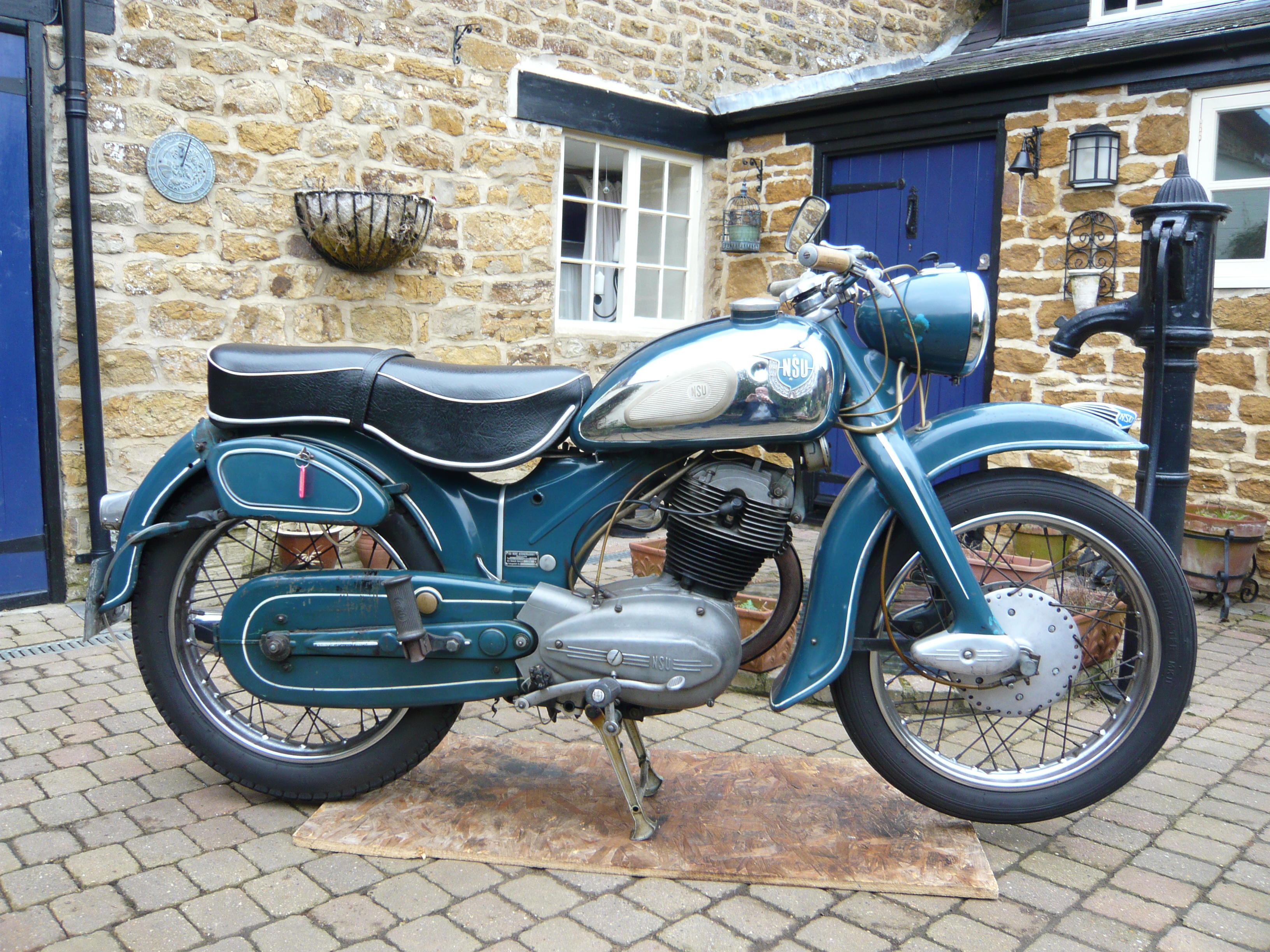Yet another motorcycle manufacturer with its roots in the bicycle industry, NSU built its first powered two-wheeler in 1900 and went on to produce some outstanding and influential designs in the 1950s, foremost of which was the 250cc Max. Announced in September 1952, the Max used a pressed-steel frame and leading-link front fork like its Fox and Lux predecessors but its most unusual feature was the Albert Roder-designed ‘Ultramax’ connecting-link drive for the single overhead camshaft. This idea was not new, Bentley had used a similar arrangement in the 1920s/1930s, but Roder’s overcame the design’s previous shortcomings. Quick for a 250 (its top speed was 75-80mph) and endowed with exceptional handling thanks to its superior cycle parts, the Max could show many a larger machine the way home over twisty terrain. Seeking to deflect criticism of the decision to withdraw its works team from Grand Prix racing at the end of the 1954 season, NSU announce that a racing version of the Max – the Sportmax – would be offered to privateers, commencing in 1955. In most respects the racer closely resembled its roadster sibling, retaining the latter’s characteristic pressed steel spine frame, swinging arm and leading-link fork, though there were numerous differences in detail. The engine was tuned and fitted with a larger (Amal GP) carburettor and megaphone exhaust system, and to cope with the Sportmax’s increased power and speed there was a very much larger front brake. Only in its rear suspension did the Sportmax differ fundamentally from the Max, using the conventional twin-shock arrangement first seen on the Geländemax off-road model. The first prototype had run at the Spanish Grand Prix at the end of 1953 and there would be several more successful outings for development prototypes during the ’54 season, the highlight of which was Georg Braun’s 2nd place at the Swiss Grand Prix, beaten only by the works NSU Rennmax of Rupert Hollaus. From the start of the 1955 season the Sportmax was simply the fastest over-the-counter 250-class racer on the market. As well as providing works-supported ‘veteran’ rider Hermann Müller with the 1955 250cc World Championship, the Sportmax was one of the most competitive lightweights of any kind available to the privateer, and in the right hands proved capable of a respectable showing in national events well into the 1960s. Other prominent stars Sportmax-mounted for ’55 included John Surtees Sammy Miller, Pierre Monneret and former NSU works rider Hans Baltisburger, while later in the decade an up-and-coming Mike Hailwood used the ex-Surtees example to spectacularly good effect. In his excellent history of the marque ‘NSU – The Complete Story’, renowned motorcycling authority Mick Walker states that well-informed sources estimate the total number of Sportmaxes produced to be 34, with a number of others constructed from spare parts after the NSU race shop was closed and sold off to the Herz family in the late 1950s. Today genuine examples such as that offered here are keenly sought after by collectors. The original Sportmax offered here was purchased in Paraguay in 2004 by the current vendor and imported into Spain that same year (the customs documents on file). Its history has been established by Mr Hartmut Schubert, an NSU specialist and historian in Germany (register entry on file). This Sportmax is probably the one raced by Rupert Hollaus in Germany (a conclusion supported by the unique construction of its fairing, which is of the type used by the factory racers) before it was sent to NSU’s subsidiary in Argentina. There it was raced by Fefro Meo, Miguel Angel Galuzzi and Jorge Cupeiro in local races to promote the NSU brand. A poster advertising one of these events in Buenos Aires and depicting an NSU is included in the sale. The Sportmax was also used by a Hungarian expatriate, Anton von Dary, to establish a number of speed records on the Buenos Aires to Ezeiza highway in December 1955. In the 1980s/90
Yet another motorcycle manufacturer with its roots in the bicycle industry, NSU built its first powered two-wheeler in 1900 and went on to produce some outstanding and influential designs in the 1950s, foremost of which was the 250cc Max. Announced in September 1952, the Max used a pressed-steel frame and leading-link front fork like its Fox and Lux predecessors but its most unusual feature was the Albert Roder-designed ‘Ultramax’ connecting-link drive for the single overhead camshaft. This idea was not new, Bentley had used a similar arrangement in the 1920s/1930s, but Roder’s overcame the design’s previous shortcomings. Quick for a 250 (its top speed was 75-80mph) and endowed with exceptional handling thanks to its superior cycle parts, the Max could show many a larger machine the way home over twisty terrain. Seeking to deflect criticism of the decision to withdraw its works team from Grand Prix racing at the end of the 1954 season, NSU announce that a racing version of the Max – the Sportmax – would be offered to privateers, commencing in 1955. In most respects the racer closely resembled its roadster sibling, retaining the latter’s characteristic pressed steel spine frame, swinging arm and leading-link fork, though there were numerous differences in detail. The engine was tuned and fitted with a larger (Amal GP) carburettor and megaphone exhaust system, and to cope with the Sportmax’s increased power and speed there was a very much larger front brake. Only in its rear suspension did the Sportmax differ fundamentally from the Max, using the conventional twin-shock arrangement first seen on the Geländemax off-road model. The first prototype had run at the Spanish Grand Prix at the end of 1953 and there would be several more successful outings for development prototypes during the ’54 season, the highlight of which was Georg Braun’s 2nd place at the Swiss Grand Prix, beaten only by the works NSU Rennmax of Rupert Hollaus. From the start of the 1955 season the Sportmax was simply the fastest over-the-counter 250-class racer on the market. As well as providing works-supported ‘veteran’ rider Hermann Müller with the 1955 250cc World Championship, the Sportmax was one of the most competitive lightweights of any kind available to the privateer, and in the right hands proved capable of a respectable showing in national events well into the 1960s. Other prominent stars Sportmax-mounted for ’55 included John Surtees Sammy Miller, Pierre Monneret and former NSU works rider Hans Baltisburger, while later in the decade an up-and-coming Mike Hailwood used the ex-Surtees example to spectacularly good effect. In his excellent history of the marque ‘NSU – The Complete Story’, renowned motorcycling authority Mick Walker states that well-informed sources estimate the total number of Sportmaxes produced to be 34, with a number of others constructed from spare parts after the NSU race shop was closed and sold off to the Herz family in the late 1950s. Today genuine examples such as that offered here are keenly sought after by collectors. The original Sportmax offered here was purchased in Paraguay in 2004 by the current vendor and imported into Spain that same year (the customs documents on file). Its history has been established by Mr Hartmut Schubert, an NSU specialist and historian in Germany (register entry on file). This Sportmax is probably the one raced by Rupert Hollaus in Germany (a conclusion supported by the unique construction of its fairing, which is of the type used by the factory racers) before it was sent to NSU’s subsidiary in Argentina. There it was raced by Fefro Meo, Miguel Angel Galuzzi and Jorge Cupeiro in local races to promote the NSU brand. A poster advertising one of these events in Buenos Aires and depicting an NSU is included in the sale. The Sportmax was also used by a Hungarian expatriate, Anton von Dary, to establish a number of speed records on the Buenos Aires to Ezeiza highway in December 1955. In the 1980s/90













Testen Sie LotSearch und seine Premium-Features 7 Tage - ohne Kosten!
Lassen Sie sich automatisch über neue Objekte in kommenden Auktionen benachrichtigen.
Suchauftrag anlegen